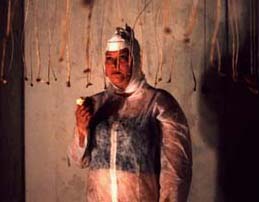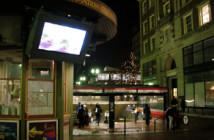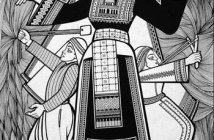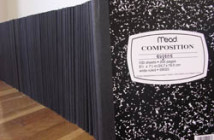MOBILIZE (the 4th in the ongoing international performance art series) presented by Mobius and the School of the Museum of Fine Arts, Boston produced by Marilyn Arsem and Jamie McMurry at the Charlestown Working Theater October 28, 2004.
It is so welcome to be reminded of the power of live art by live artists to rattle and stun. On October 28 at the Charlestown Working Theater, Jamie McMurry (Boston), Tamara Paris and Matt Fontaine (Seattle), and Mari Novotny-Jones (Boston, Mobius Artists Group) presented bracingly candid work. At the end of the evening, people in the audience were crying. I’m not kidding.
For me, the three pieces built as a series. Right at the start, seconds into McMurry’s performance, I scrawled, “Must Performance always be about masochism?” Gnashing, wailing, the cracking together of jars with bare knuckles, the drinking of an entire bottle of whisky, the stripping of clothes, and tremulous sobs… in less able performers, this might have been mawkish. For sincere artists who deal in autobiography, however, (read: McMurry, Paris & Fontaine, Novotny-Jones) performance work seems to necessarily center on exquisite pain. Performance in general is fleeting and uncomfortable. To put it simply, so is the human condition.
I also felt a countervailing theme involving the permanent fixing of things, an effort to pin images down in manageable 2-D.
While McMurry actually forbade any picture taking or filming (saying you can’t deconstruct something properly if there is an archive), his piece nonetheless created a series of tableaus. Performing in darkness, he turned an audience member and a construction site light into a deliberately paced strobe by commanding “On/Off” at intervals. These were snapshots; his silhouette seared a white afterimage on my retinas.
Paris and Fontaine’s piece began with a parameter-setting self-portrait that they drew in tandem in white ink on a wide, full-length mirror. They swiped at the drawing for the rest of their performance, erasing it slowly, piece by piece. This was the punctuation to their series of otherwise unmitigated domestic scenes.
Pre-show, Novotny-Jones busily took Polaroids of the waiting audience. I saw her out of the corner of my eye, labeling the first batch with a pen. As it always is with cameras, once I noticed hers, I became terribly anxious about whether she would get around to taking mine and what I would do. Her piece ultimately concluded with these photos’ ruin, buried under thick red paint and wafts of flour.
In keeping with their program, this will be an article of Polaroids, strange but legible distortions of time-based moments. Also, disposable. (You should have been there!)
_
Children are Better Seen than Heard:
Jamie McMurry
The audience filed into the second floor room McMurry had prepared. We noticed three highly frosted cakes labeled ‘regression, deconstruction, destructive.’ McMurry stood in the other half, which was covered from floor to walls with black plastic and artfully composed with found props (can opener, jars, frosted cakes, a miniature picket fence, badminton racquets, toy deer, and more.)
I took those cakes to be McMurry’s “command list.” The lights went off.
McMurry’s program notes talked about transubstantiation. At each flash of light, I looked for state changes. With each crushed can, smashed cake, or broken jar, the contents sloshed across McMurry’s body. We could hear, and smell, the regression, destruction, deconstruction (to use his terms) but we could see only these elements as they’d been applied to him, and only occasionally. McMurry’s features seemed to me loose and purple. He was making intense and clumsy attempts at turning violent action incarnate.
After an extended program of systematic breaking, plus heavy breathing and the found sound of children’s toys, McMurry suddenly left the light on. He ripped down the plastic on the walls to reveal two windows, illuminated from outside. Two giant images of horse heads covered the bottom panes. It was a horror trope: an unexpected presence revealed, static and graphic. The Godfather.
McMurry ended by switching on a TV set and we all watched quietly. The video was footage of McMurry, looking away from the camera and seemingly driving, talking about what he would buy for the performance that day. He named items like “2 mason jars that I will etch my name into” and “brown corduroy pants.” My friend pointed out that his oral list functioned as a self-portrait-as-media-list. The video was black and white, high contrast, Pop.
Jessica Stockholder, a well-known artist, makes room-size assemblages of everyday objects and brightly colored paints. She has a unique way of thinking about balance in disparate compositions. In one of her works, a partitioned area in a room gets filled with working space heaters, creating a 3-D shape of heat that directly balances a cage filled up with oranges (which are tropical and warmly colored.)
I think McMurry’s piece exploited an even greater, uncanny synesthesia of volumes. Our bodies crammed into one side of the room. We looked one way; he looked resolutely back out. With the lights off, he stripped down to a child-size catcher’s chest guard. With the occasional flashes, we would see broken glass, strange liquids. His side seemed cold, cold, cold to our warm, fidgety rustling bodies. The darkness made me hyperaware of small movements on both sides of the divide. I was scared to take notes, scared that I would be sprayed with shrapnel.
“What We Talk About When We Talk About Jamie”
Tamara Paris and Matt Fontaine
This work was in another upstairs room. The audience stood at the perimeter this time, around a card table that was set with a big bottle of whisky, a cheap-looking sour mixer, Marlboros, a cocktail shaker (plastic), a bag of ice, a small pyramid of powdered sugar donut holes, and drinking glasses. Paris and Fontaine were already in the room and were wearing white bathrobes and a few raggedy white bandages on their feet. They cut bumbling figures, both larger and sloppier than life. This was a domestic scene. My boyfriend and I later agreed that our own at-home behaviors felt implicated.
As we entered, the artists were engaged in drawing a double self-portrait on an immense mirror that probably covered an old fireplace. This activity was surely an agonizing thing. Each stood stoically and looked into the mirror and watched the other draw him back, slack jawed and moony. Although they looked inward at the ongoing drawing of themselves, the resulting portrait was of a couple turned away from each other. But they drew a third figure together, an elongated female with droopingly long feet positioned in space between the two of them. The room was VERY BRIGHT. Hospital bright.
Then they sat down at the table and began the show. I think they meant to show us that they were not performing. They were hanging out, smoking and drinking (a lot!), with flourishes and piss-taking. Neither Paris nor Fontaine made any eye contact with the spectators. This was quite a feat in a theater in the round. So I wondered, was it satire? Burlesque? Exorcism?
The work also had a feeling of being hard work. There was an extended period of settling in and bearing down at the task of delimited debauchery. The audience got fidgety. Fontaine and Paris blithely continued to crack each other up with disgusting, disgusted actions. Fontaine retched into the trash, then immediately scarfed more donut holes, all from his seat at the table. They stopped being charmingly happy together and became ugly and gross.
They were a bit fat. Their robes gaped. They were inscrutable, mad hatters. I assumed they were playing at husband and wife. From time to time, one would march over to the portrait and erase a bit. Meanwhile, I ran through the many options for marking progress toward the piece’s consummation. Was it the erasing of the whole third person? The drinking of all the booze? The eating of all the donut holes? The smoking of all the cigarettes? The melting of all the ice?! The filling of all the trash? The piece seemed like a series of consumptive dares. We wondered who would spew first, next, and last.
Eventually, the drawing disappeared. He exited first. Then she, unsteadily. Then, we left too.
Album: a meditation on memory and loss
Mari Novotny-Jones, Mobius Artists Group member
When the audience next came back to the lobby, we were asked to take off our shoes and enter the theater quietly. Inside was a stark, scorched earth scene. There was a large square of what looked like white muslin on the floor. Maybe seven copper tree forms marked the edges and were hung with Polaroid pictures. In the middle was an unmarked mound in a suspicious shape. Novotny-Jones invited us to step onto her fabric. Her piece hinged on direct interaction with the audience. She made nearly constant eye contact.
Novotny-Jones’ first act was an album of ad-libs. She walked around the space and named each person she had photographed, stating a relationship to her, with occasional personal commentary. These improvised familial ties positioned each audience member in a personal landscape. Old timey church music played from a stereo.
When Novotny-Jones wears her white-as-snow hair down, she inevitably strikes an Earth Mother figure. But these homely images underwent a rapid phase change when Novotny-Jones pulled out a piece of Tupperware filled with glossy blue paint. She asked a student to hold it and plunged her figures in and smeared the blue across her face into a disturbing balaclava. She then proceed to smear all of herself with the blue paint, covering her legs with the color before she took off her velvet shift, so that she never seemed “nude.” Just naked.
She then plunged into the mound. Its effect was that of a down-filled land mine. Feathers stuck to Novotny-Jones' body in bits, covering even much of her face. She was like a startled cartoon bird, holding her head at an angle and blinking out at the audience. This was a perfect embodiment of vulnerability. From the back, it actually looked like she was wearing chaps.
Novotny-Jones approached an audience member slowly. She hugged the woman. Down, paint, flesh, and all-- right across the street clothes she had arrived in. There were more hugs. Such direct interactions were like overly passionate public kisses. We were marked people. When Novotny-Jones came close to me, I anxiously avoided eye contact. She spared me. I wanted a hug, but did not want to be hugged, but thought maybe I needed to be, and I wasn’t even touched in the end.
The piece’s conclusion was rapid. Novotny-Jones poured sheets of red paint down over her head. It was too smoothly viscous to be blood. She poured the paint on her photos, and then let funnels of flour rain down. At last, she began to sing the chorus of Swing Low Sweet Chariot. The drunken performers from the previous piece (now looking well-scrubbed) joined in right away. Then most everyone else did too. Novotny-Jones quickly exited and we were left to find our shoes and stumble out into the light. I don’t know if I thought this was an ascension. But, it was certainly enough to make me weepy.
Links:
Mobius
The School of the Museum of Fine Arts
All images are courtesy of the artists, Bob Raymond, SMFA, and Mobius.
Anneka Lenssen must confess that she is the Mobius Board of Directors president. She is a regular contributor to Big, Red & Shiny.




